The young typist must have been embarrassed. It happened way back in the days when typewriters were still commonly used, and perhaps it was the client who pointed out the spelling mistake. Wanting to make up for it, she typed a quick note of regret: “I apologize for the typing errow.”
Have you had days like that? Too often I notice a typo just after hitting Send on an email or Publish on a blog post. Why is that? I think it’s because I know what I meant to type, and my brain just assumed that it communicated what I wanted to. It would be more effective to get someone else to look over the text first, but there’s not always someone else around.

That’s where grammar checkers come in. They’re a lot more sophisticated than the simple spell checkers of yesteryear. Those basic tools did little more than ensure the words you type are in the dictionary. They’re robotic tools with no intelligence, and miss all but the most basic errors.
Today’s grammar checkers have come a long way. Even if a word is in the dictionary, they can tell if it’s the wrong spelling in context. Grammar and punctuation errors are also consistently identified. The best tools even help you make your writing more readable and warn of potential copyright violations—all before you hit Send or Publish.
The best tool for the job is Grammarly. It includes all of these features and more, and often feels more like an intelligent human pointing out my errors than a computer program. It’s pricey, but many users find the money well spent. The company also offers significant discounts regularly and provides the best free plan in the business.
ProWritingAid is an excellent alternative. It matches Grammarly feature for feature and is more affordable—but it doesn’t feel as slick. ProWritingAid’s advice feels like it’s coming from a program rather than a person.
In this article, we’ll cover Grammarly and ProWritingAid. We’ll also analyze four full-featured grammar checkers, free web-based tools, and your word processor’s grammar checker. Which is best for you? Read on to find out.
Table of Contents
Why Trust Me for This Guide?
My name is Adrian Try, I’ve been writing professionally for over a decade; many of my jobs before that involved writing in one form or another. I purchased my first grammar checker in the early 1990s—a DOS program that wasn’t very helpful. It nagged me robotically about overuse (or any use) of the passive case and seemed to quote rules more than giving advice. I’ve tested grammar checkers on and off for years, and not much has changed.
Then I ran into Grammarly several years ago. I suddenly discovered a grammar checker that felt genuinely intelligent. It picked up my spelling and grammar errors, let me switch the wrong word for the right one with a single click, and succinctly explained what I had done wrong.
The Premium plan goes further and offers to help you improve your writing. I’ve been using the free version for the last year-and-a-half, and according to Grammarly, it’s checked almost two million words that I’ve written.
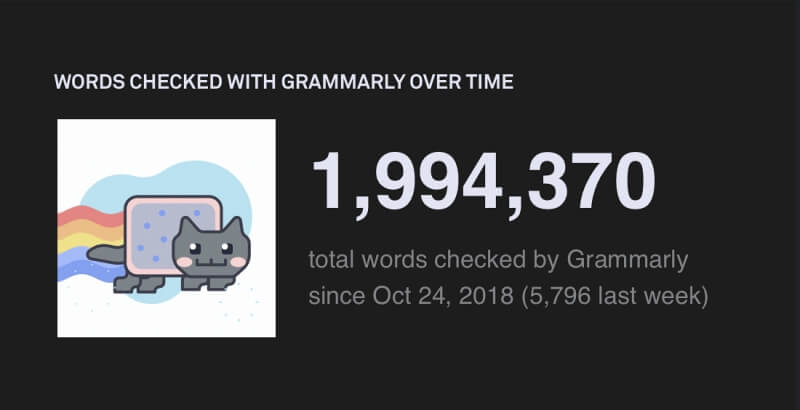
In recent weeks I’ve thoroughly tested four other grammar checkers, and while writing this roundup, I’m checking two more. I tested them all on several platforms using the same test document for easy comparison of their accuracy and ease of use.
My conclusion? I discovered they’re not all the same. In this roundup, I aim to show the differences between them clearly.
Who Needs a Grammar Checker?
Who should consider using a grammar checker? Anyone who can’t afford to have their work go out with spelling and grammar errors, along with those who are on a mission to improve their English and the clarity of their writing. That includes:
- Professional writers who make a living stringing together correctly-spelled words in grammatically precise sentences. Writers should consider a grammar checker an essential business expense.
- Those who are serious about writing but not yet making money from it, including budding novelists, screenwriters, and bloggers
- Professionals and business people who need to write as part of their job. That may include sending vital emails and other correspondence, writing proposals and applications, and updating the company blog. Errors can reflect poorly on your business, so it’s essential to avoid them.
- Those who know they are not talented at spelling or grammar. The right grammar checker will help you find those errors before it’s too late and may help you become more confident.
- Students can use it to check their essays and assignments before handing them in. Why lose marks if you don’t have to?
- Those who are learning the English language. English is possibly the least consistent language in the world, and these apps can be valuable learning aids.
Best Grammar Checker: The Winners
Best Choice: Grammarly
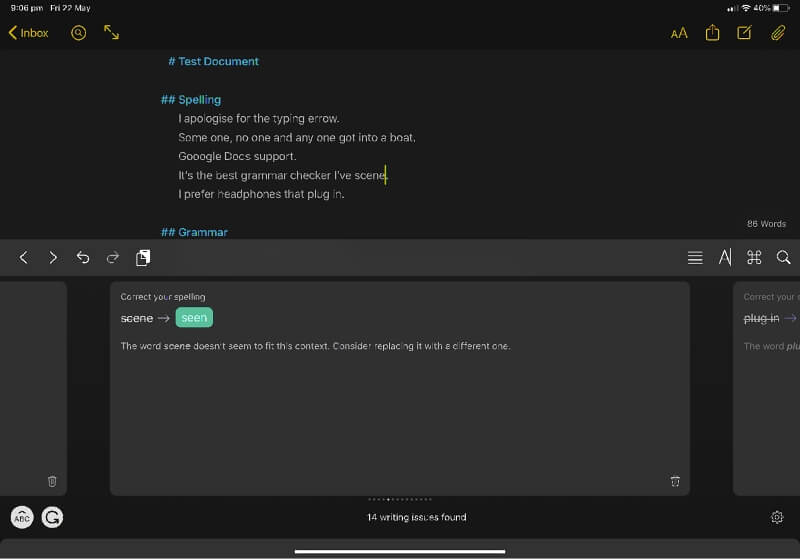
Grammarly is the premium grammar checker and deserves strong consideration. It has more features than any other program, and I found the app to be more accurate and more helpful than any other. Grammarly has the most expensive advertised plans, but also offers substantial discounts regularly. It also includes a highly useful free plan. Read our full Grammarly review here.
You can download Grammarly from the official website (Mac, Windows, browser extensions). A generous free plan is available. Subscribe to the Premium plan for $139.95/year. Grammarly’s business plan costs $150/user/year.
Grammarly works on:
- Desktop: Mac, Windows
- Mobile: iOS, Android (keyboards, not apps)
- Browsers: Chrome, Safari, Firefox, Edge
- Integrations: Microsoft Office (Windows and Mac), Google Docs
Grammarly will check your text for correctness, clarity, delivery, engagement, and plagiarism. It works on most major platforms. The online version offers extensions for four browsers and supports Google Docs. There are native apps for both Mac and Windows. They also plug into Microsoft Office on both platforms. On iOS and Android, special keyboards are available that check your spelling and grammar in any mobile app.
It’s the only app to identify every error in my text document and correct it quickly and easily with just the free version. Its accuracy and reliability have given me great confidence over the last year and a half that I’ve used it.
I usually check my drafts using Grammarly once I’ve moved the document to Google Docs, just before submitting them. I prefer not to obsess about getting everything right as I’m writing—instead, I focus on maintaining momentum. If I want to use Grammarly with a program that’s not supported—say, Ulysses—I turn to the Grammarly keyboard on my iPad.
All of that is available with the free plan. The Premium plan gives access to several other significant features, starting with Style checking. Besides checking for correctness (errors marked in red), Grammarly Premium also checks for clarity (marked in blue), engagement (marked in green), and delivery (marked in purple).
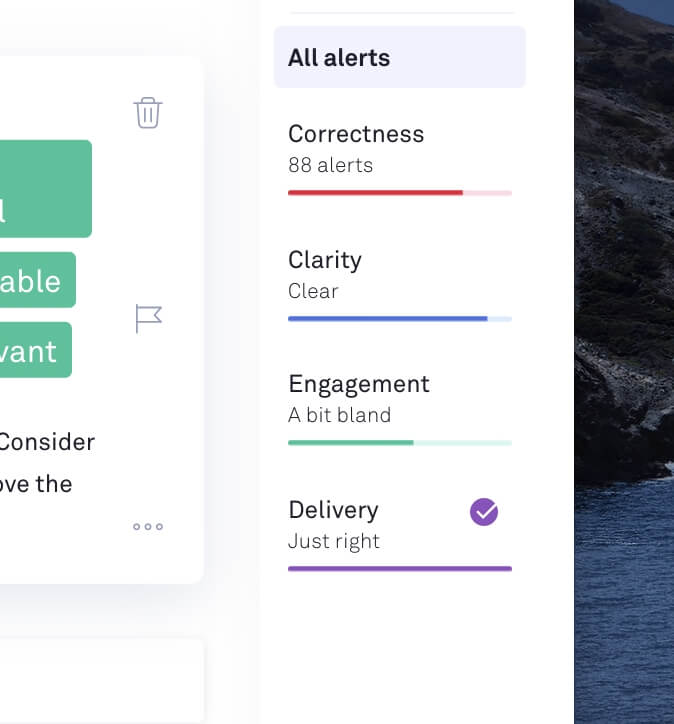
I had Grammarly check one of my old drafts, and received high scores for clarity and delivery, but my engagement needed a bit of work. The app found the article “a bit bland” and suggested how I can spice it up.
Some of the adjectives I used are often overused; more colorful replacements were suggested. Some of these changed the tone of the sentence too much, and others were fitting. For example, Grammarly suggested replacing “important” with “essential,” a much stronger word.
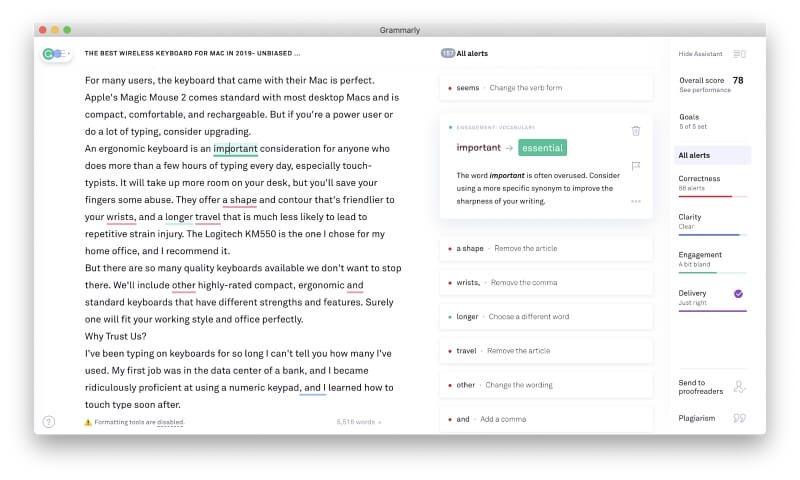
It also identified words I used too frequently in the article, when I could communicate a thought using fewer words, and when a long sentence could be split into two shorter sentences. Not all of these suggestions had one-click solutions; some left me to do my own thinking and changes.
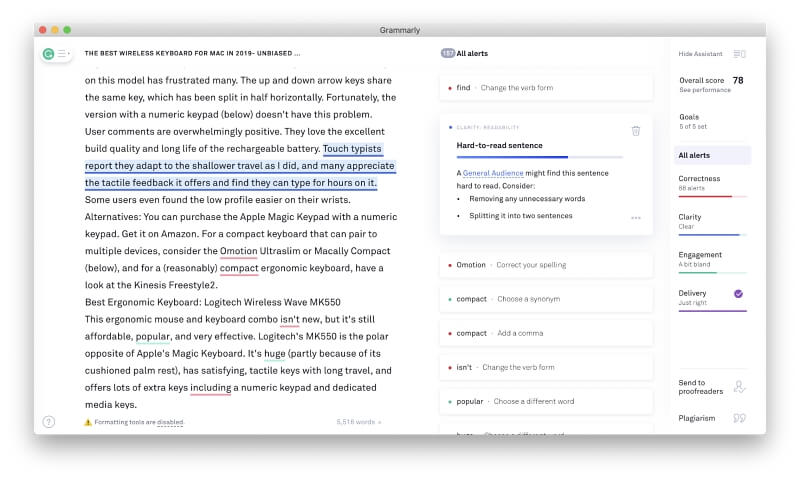
Another Premium feature is checking for plagiarism. Grammarly is the only grammar checker I’m aware of that allows you to perform an unlimited number of these in the plan’s cost. Other apps require you to purchase more once you reach a limit.
That means that if you perform a lot of these checks, Grammarly offers excellent value for money. For example, while ProWritingAid starts at half the price of Grammarly, it will become more expensive if you perform over 160 plagiarism checks per year (about three a week).
To test this feature, I imported a couple of 5,000-word Word documents into the Mac app. One contained a few quotes, while the other didn’t. Checking each one for plagiarism took about a minute. The second document was given a bill of clean health.
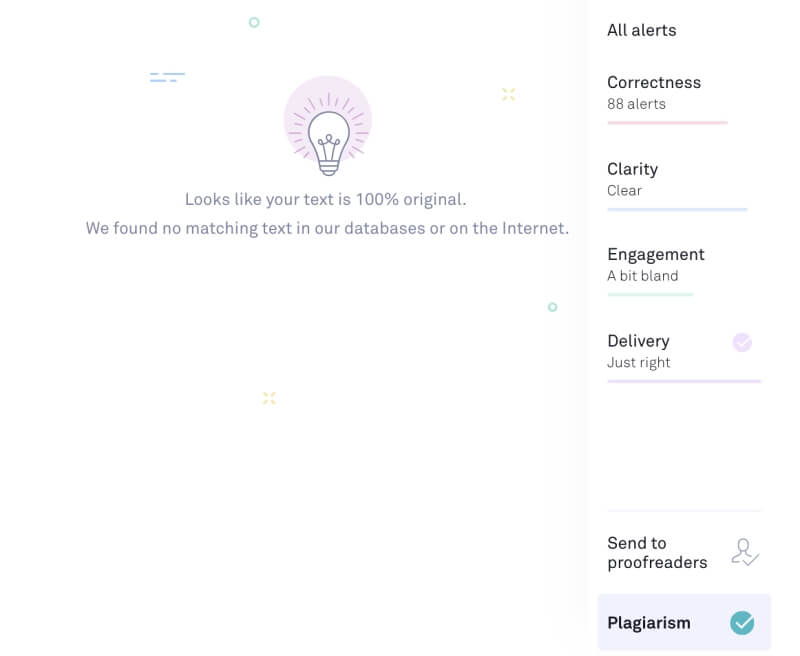
The first document had already been published on SoftwareHow and was identified as virtually identical to that web page. The sources of seven quotes throughout the article were also identified.
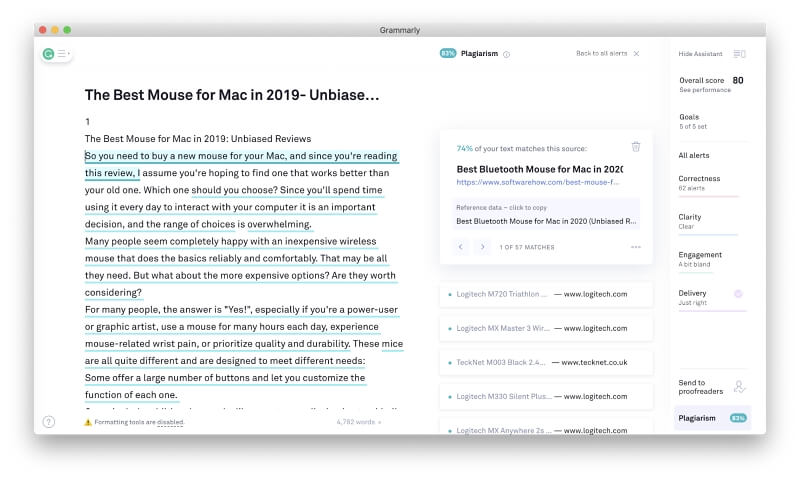
The results aren’t perfect, however. As a test, I blatantly copied some text from several web pages, and these potential copyright violations were not always flagged.
Grammarly suits my needs better than any other grammar checker. I can use it without changing my workflow, and even the free plan compares well with the features of some of its competitors. While the published subscription prices are high, generous discounts are sometimes available that make it just as affordable as the other apps.
Also Great: ProWritingAid
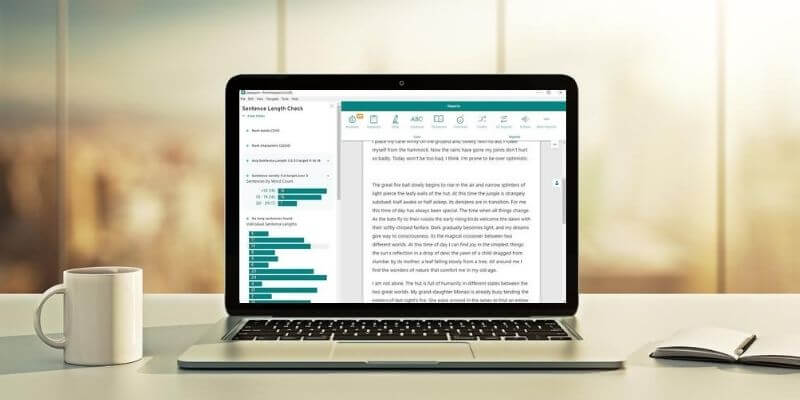
ProWritingAid is Grammarly’s closest competitor. It matches Grammarly feature-by-feature and platform-by-platform (except mobile), and for most people, a Premium subscription will cost half as much. It’s not as slick as Grammarly, and its free plan is too limited for real work; really, it’s only appropriate for evaluation purposes. Read our full ProWritingAid review or detailed comparison of ProWritingAid vs Grammarly here.
You can download ProWritingAid from the developer’s website (Mac, Windows, browser extensions). A limited free plan is available. Subscribe to the Premium plan for $20/month, $79/year, or $299 lifetime (with a free 14-day trial).
ProWritingAid works on:
- Desktop: Mac, Windows
- Browsers: Chrome, Safari, Firefox
- Integrations: Microsoft Office (Windows), Google Docs, Scrivener
Like Grammarly, ProWritingAid will check your documents for spelling and grammar errors, suggests how you can improve your writing, and checks for plagiarism. Both apps identified all of the spelling and grammar errors in my test document, but ProWritingAid is less opinionated about punctuation and didn’t make any corrections there.
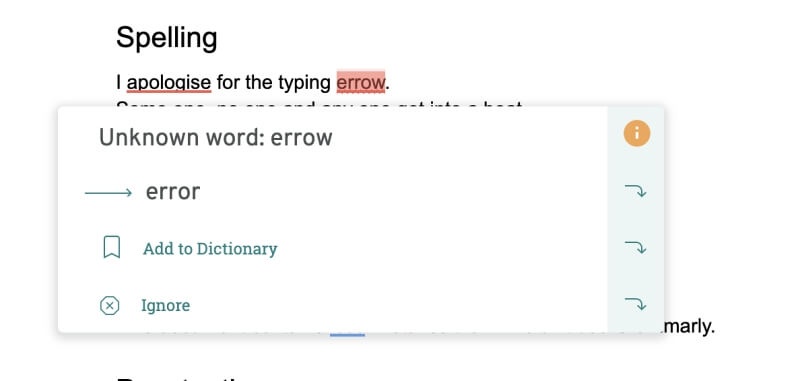
Its interface is similar to Grammarly’s, and making corrections is easy. It integrates with Microsoft Word and Google Docs. Unlike Grammarly, it also supports Scrivener.
ProWritingAid suggests how to improve the style and readability of my writing, and points out unnecessary words that can be eliminated, adjectives that are weak or overused, and overuse of the passive tense. Not all suggestions are improvements.
Where ProWritingAid excels is by offering a wide range of detailed reports—20 in total, more than any other grammar checker I’m aware of. These can be studied when you’re not rushing to complete the current writing project, and identify how you can improve readability, where you’ve overused words or used stale clichés, have written sentences that are hard to follow, and more.
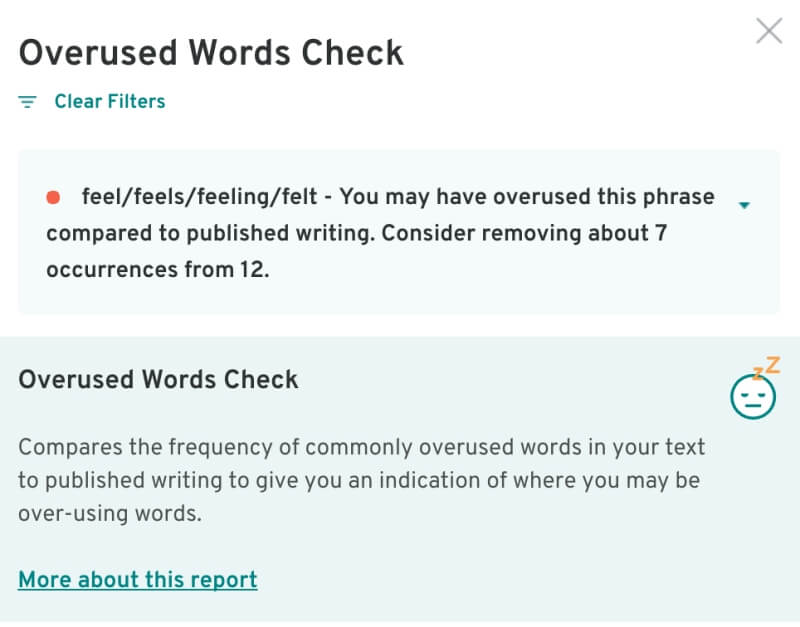
ProWritingAid’s plagiarism check is as fast and accurate as Grammarly’s but is not included in the price of a normal Premium subscription. A Premium Plus subscription costs an additional $10 and includes 60 plagiarism checks a year. Further checks can cost between $0.20 – $1.00 each, depending on how many you purchase in advance.
Other Good Grammar Checking Tools
1. Ginger Grammar Checker
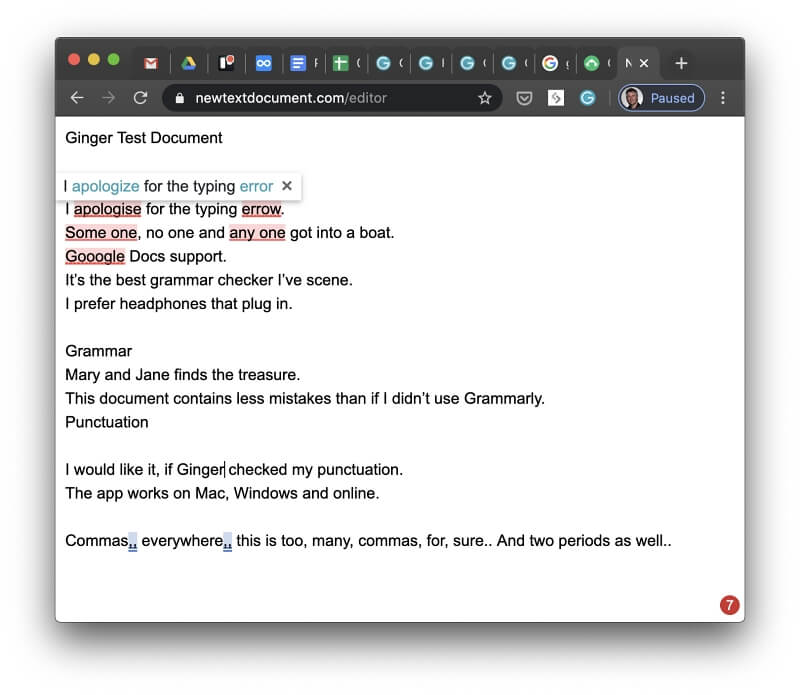
Ginger Grammar Checker offers browser extensions for Chrome and Safari and a desktop app for Windows users only, as well as mobile apps for both iOS and Android. It will pick up many of your spelling and grammar mistakes, but in my tests, it also lets some glaring errors through. My experience with the app left me not trusting that it will catch all of my mistakes. Read our full Ginger review here.
Download Ginger from the developer’s website (Windows, browser extensions). A free plan is available. Subscribe to the Premium plan for $20.97/month, $89/year, $159.84 biyearly.
Ginger works on:
- Desktop: Windows
- Mobile: iOS, Android
- Browsers: Chrome, Safari
- Integrations: Microsoft Office (on Windows)
Unfortunately, Ginger identified far fewer errors in my test document than Grammarly or ProWritingAid. I first tried the free plan and was so unimpressed I immediately subscribed to Premium, expecting to receive better results. I didn’t.
It flagged most of the spelling errors of my test document but missed “scene,” which should be “seen” in context. It also failed to find any grammar errors.
I was also disappointed with Ginger when checking a test email in Gmail’s web app. While it correctly identified many of the errors, it let the sentence “I hop you are welle” slip through. That’s unacceptable.
Ginger offers a dictionary and thesaurus, but unfortunately, you can’t click on a word to look it up—you need to type it in manually. It also offers a Sentence Rephraser that promises to show you some alternative ways to express the sentence. This feature sounds promising, but unfortunately, it doesn’t rearrange the sentence at all. Instead, in each instance, it just substitutes a single word, usually with a synonym.
2. WhiteSmoke
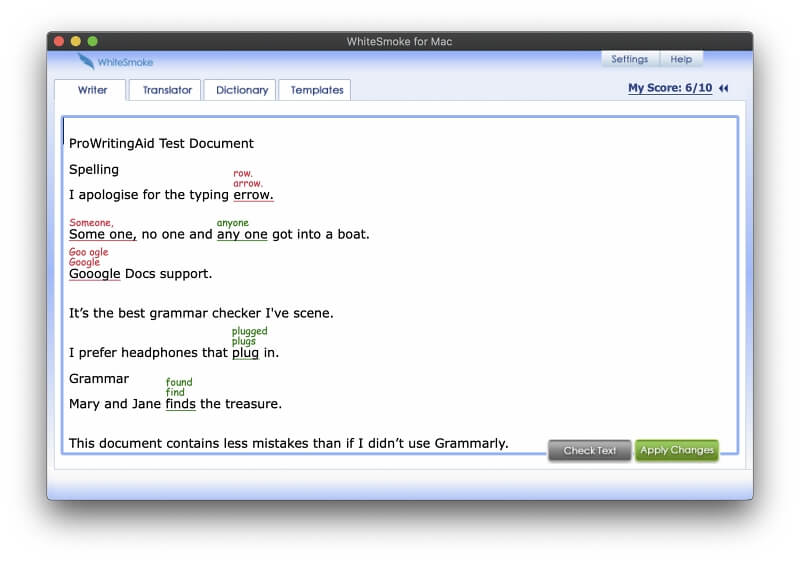
WhiteSmoke seems to be designed for students rather than professionals and business people. I found it more accurate at detecting errors than Ginger, especially when using the latest version, which is currently only available for Windows. However, neither a trial version nor a free plan is available, so to test the app, you’ll have to purchase a full year’s subscription.
Download WhiteSmoke from the developer’s website (Mac, Windows). Subscribe to the Premium plan for $79.95/year (or $59.95/year for web access only). A Business plan adds phone support and an extended warranty and costs $137.95/year.
WhiteSmoke works on:
- Desktop: Mac, Windows
- Browsers: generic web app (no browser extensions)
- Integrations: Microsoft Office (on Windows)
Rather than just underlining errors like most other grammar apps, WhiteSmoke displays the alternatives above the word, which I find helpful. On the Mac and online applications, both spelling and grammar errors were identified in my test document, but not all of them. It made the wrong suggestion for “errow” (the only app to do this), and also missed “scene” (which should be “seen”) and “less” (which should be “fewer”).
The Windows version is the latest version (the other platforms should be updated soon) and picked all of these errors correctly. That’s promising, but I also noticed that there were a few false negatives. For example, it tried to correct “plug in,” which is already correct.
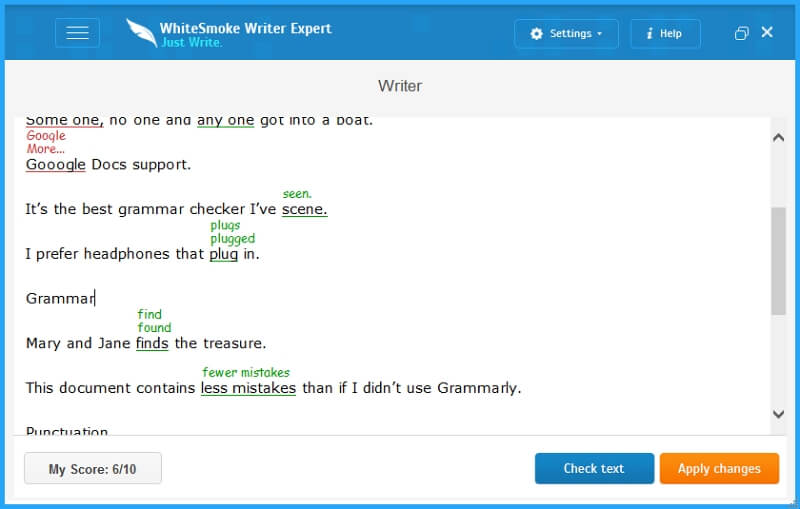
A plagiarism checker is also available, but I can’t recommend it. First, it only supports documents up to 10,000 characters (roughly 2,000 words), which is impractically low. Second, the checks were unusably slow. I gave up on checking a 9,680 character document after four hours but did complete a test on a short 87-word document.
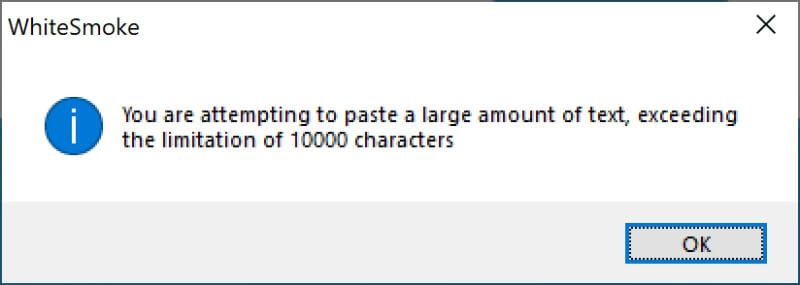
Third, there are far too many false positives. Almost any word or phrase found on other web pages is marked as plagiarism. In my test that included the phrase “Google Docs support” and the single word “Punctuation,” there’s no way they should be considered plagiarism—but they were.
3. LanguageTool
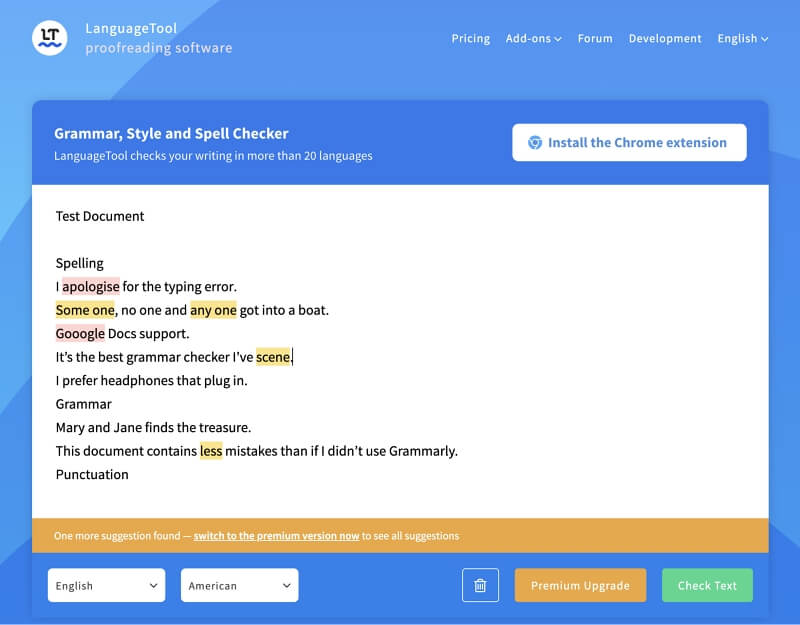
LanguageTool offers a free plan that can test 20,000 characters and a Premium plan that can test 40,000 characters. It works online in Chrome and Firefox, and plugins are available for Microsoft Office and Google Docs. To run it on your desktop, you need to use a Java app.
You can download from the developer’s website (Java app, browser extensions). Subscribe to the Premium plan for $59/year. A free plan is available.
LanguageTool works on:
- Desktop: Java app runs on Windows and Mac
- Browsers: Chrome, Firefox
- Integrations: Microsoft Office (Windows, Mac, online), Google Docs
I ran my standard test document through LanguageTool, and it successfully found most errors. A message at the bottom states, “One more suggestion found—switch to the Premium version now to see all suggestions.” That’s because that version performs several additional checks that the free version doesn’t.
Although I haven’t fully reviewed LangageTool, I noticed there are add-ons for Google Docs, Microsoft Word, and LibreOffice. There is also a vast number of plugins created by the community that allow you to access the app from email programs, text editors, and IDEs.
4. GradeProof (Now Outwrite)
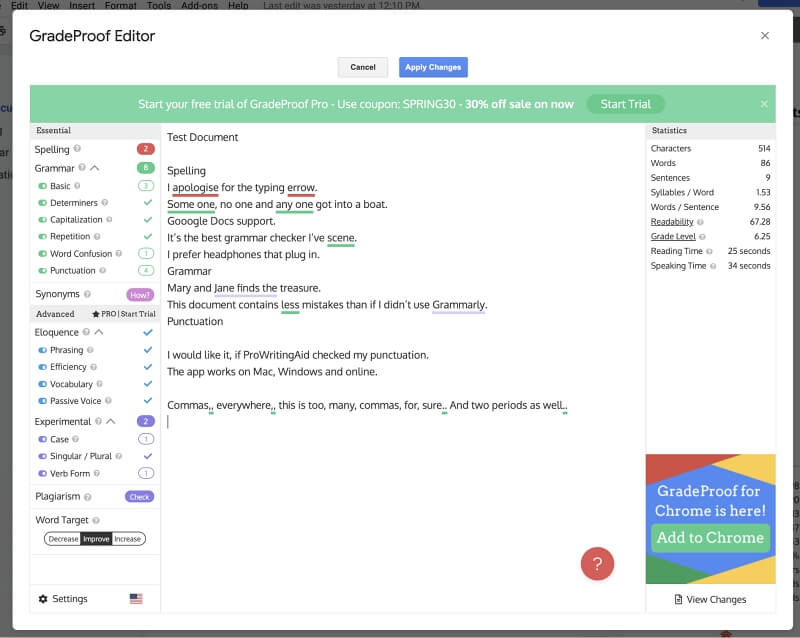
GradeProof (now Outwrite) is designed for students but is a useful and accurate tool for professionals and business people as well if it works where you do. It supports a limited number of platforms: the Chrome web browser and iOS devices.
Install the GradeProof Chrome extension from the developer’s website, or download the iOS app from the App Store for free (in-app purchases unlock all features). Pro subscriptions cost $17.47/month, $31.49/quarter, or $83.58/year and include 50 plagiarism credits per month. A free plan is available. You can access a free Pro trial once you submit your credit card or PayPal details.
GradeProof works on:
- Mobile: iOS
- Browsers: Chrome
GradeProof performed well when checking my test document. It found every spelling mistake and grammar error but doesn’t recognize company names. It marks “ProWritingAid” as an error, but has no problem with the misspelled “Gooogle.”
I appreciate the detailed document statistics in the left pane. A notice at the top of the screen gave me a discount code to receive 30% off a GradeProof Pro subscription.
I can see the Pro features listed at the bottom of the left pane and notice that it will check my writing by considering the efficiency, phrasing, vocabulary, and use of the passive tense in my text. Some experimental features, word targets, and plagiarism checks are also included.
I had one bad experience with the app. I checked the draft of this article using GradeProof Pro once I’d moved it into Google Docs. I spent around 20 minutes working through the suggestions in a pop-up editor. When I clicked on the Apply Changes button, an error message was displayed, and all of the changes were lost.
A Pro subscription includes 50 plagiarism checks per month. I didn’t test the effectiveness of this feature.
Alternatives to Grammar Checker Software
Free Online Grammar Tools
There are tons of free online spelling and grammar checkers. Just paste some text into a text box on a website. Most of these pick up at least a few errors but may miss some significant grammar mistakes.
After the Deadline is free for personal use; however, it didn’t identify any errors in my test document.
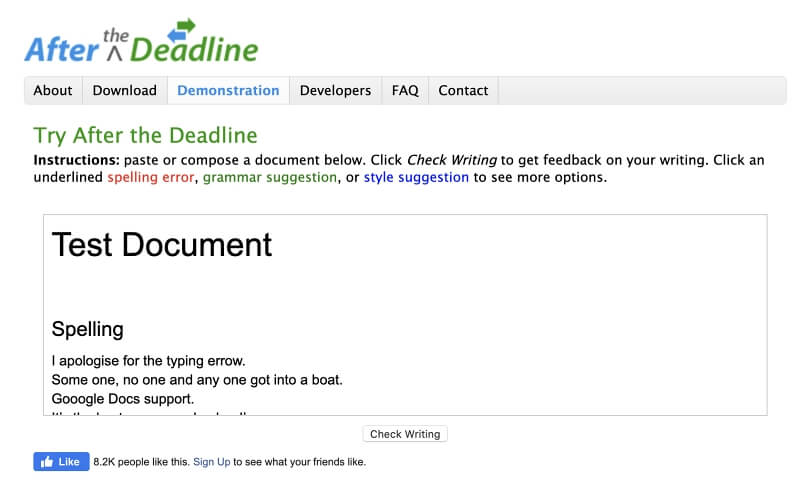
Virtual Writing Tutor is a free online grammar checker that generates a report rather than correcting in-place. It correctly picked up most of the errors in my test document.
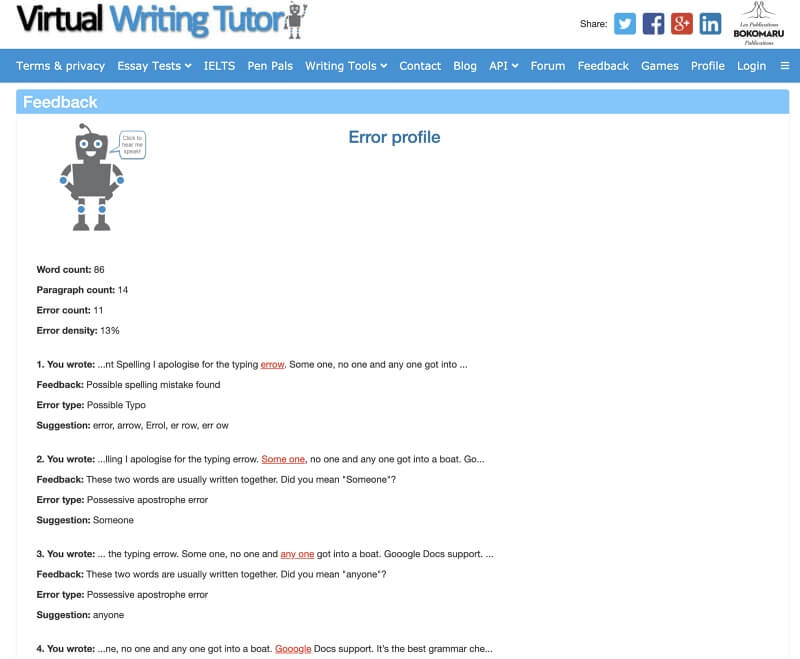
Scribens is also free and found many of my errors, but missed two significant grammar mistakes.
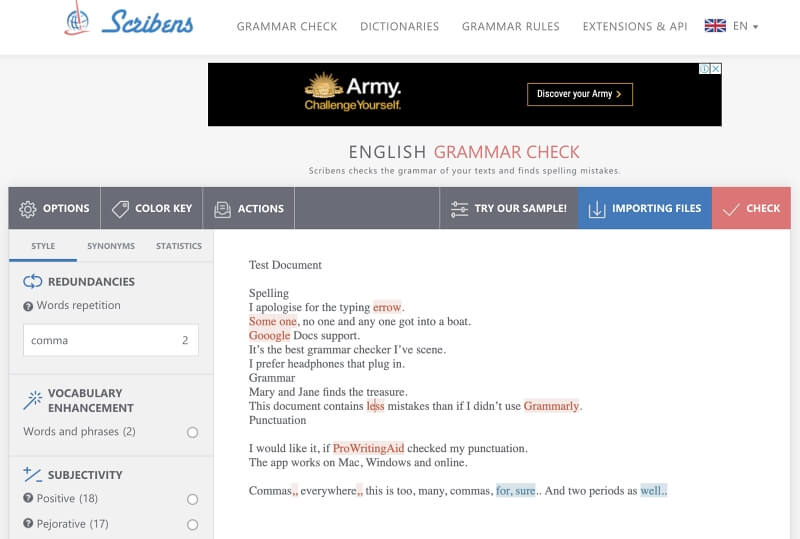
Nounplus is another free alternative, but lost the line endings of my pasted text and missed most of the errors.
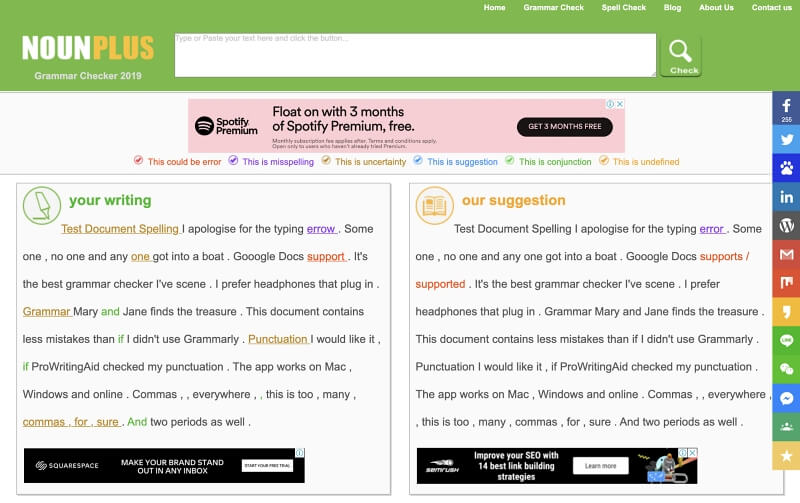
GrammarChecker found a few basic errors but missed most of my grammar mistakes.
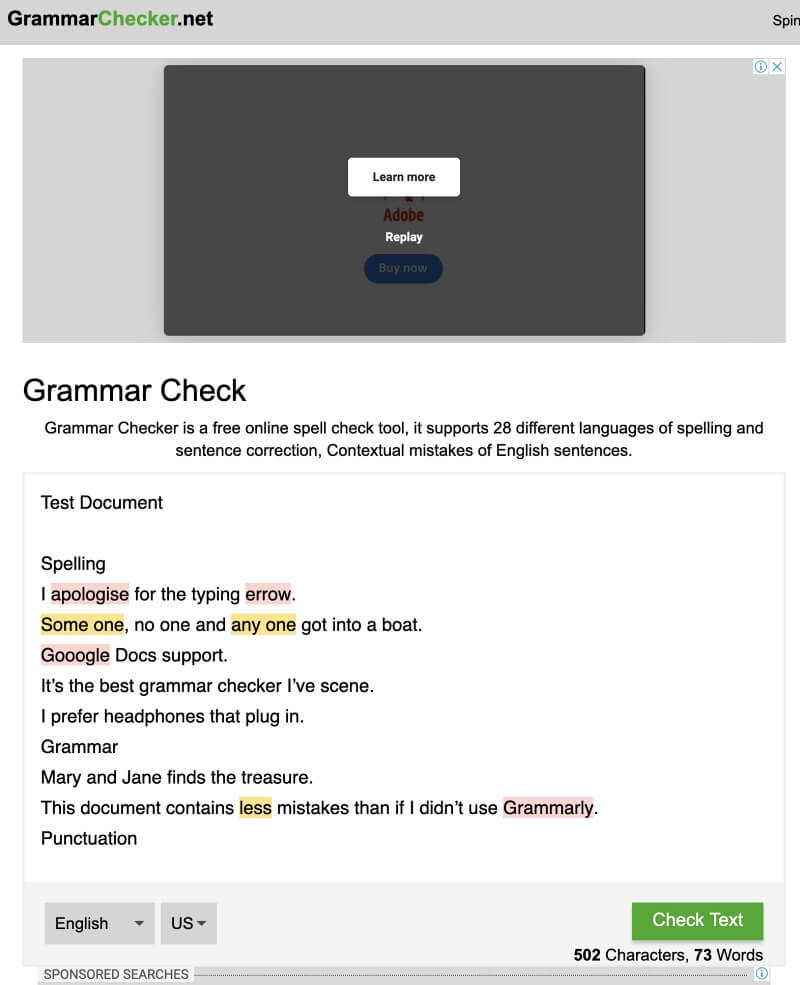
SpellCheckPlus picked up my spelling mistakes but missed the grammar errors.
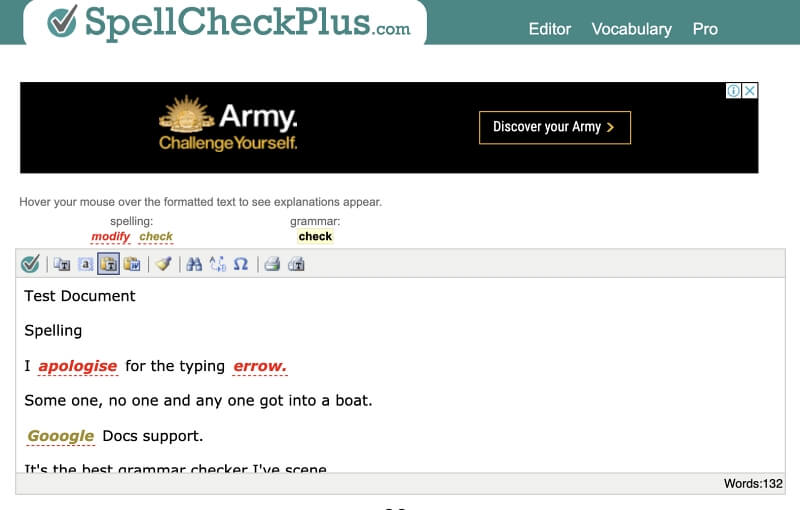
In-App Grammar Checkers
Many word processors and writing apps include grammar checkers. However, they are not as comprehensive or helpful as the dedicated apps we review above.
Microsoft Office checks your grammar, spelling, and more and offers suggestions. It also checks for issues of style, including making your sentences more concise, choosing simpler words, and writing with more formality.
Google Docs offers basic spelling and grammar checking. It identified some of my spelling mistakes and one grammar error.
Scrivener also has a spelling and grammar checker, but on the official forum, users describe it as annoyingly laggy and “inadequate to the point of being useless.” It’s probably not as helpful as Microsoft’s tool. I found that one Scrivener user always checks their documents in Word afterward to make sure that nothing was missed.
Ulysses – a grammar checking feature is coming soon to Ulysses. In a recent email about Ulysses Beta 20, they mentioned that one of the new features would be “an advanced text check in over 20 languages.” Although I signed up for the beta, I don’t have access to it yet, so I can’t comment on how effective or comprehensive this will be.
Other Apps
Hemingway is a free online tool that doesn’t check grammar but does identify readability issues. However, it doesn’t offer solutions, and seems over-sensitive at labeling sentences “hard to read.”
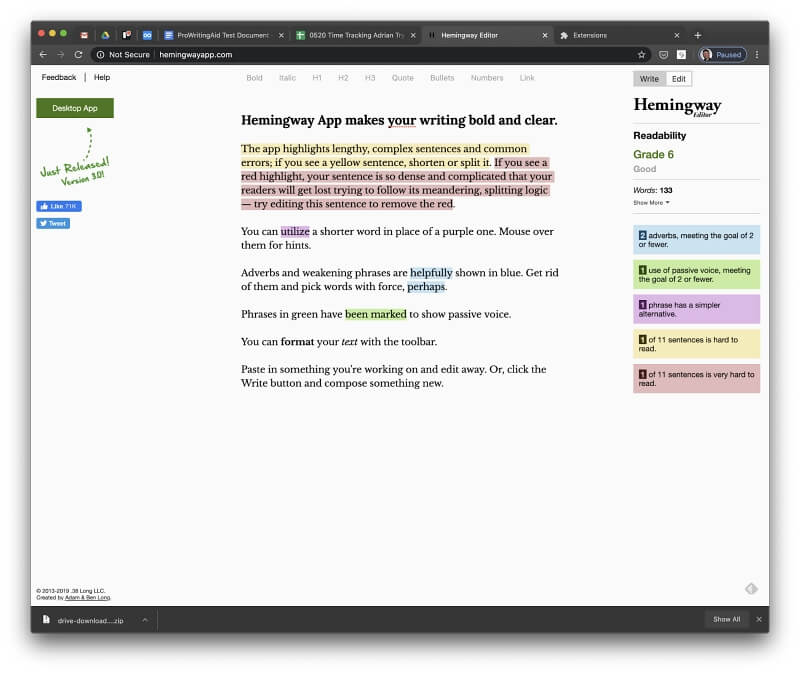
Nevertheless, it is helpful and complements rather than competes with the grammar programs reviewed above—especially those that don’t check for style.
How Can a Grammar Checker Help?
What can you get from a grammar checker? Read on to find out.
Context-Sensitive Spelling Corrections
Traditional spelling checkers just made sure the words you typed were in the dictionary, not whether they made sense in context. They would miss errors like, “You didn’t spell that word write.” Since “write” is in the dictionary, and the app doesn’t understand the sentence, it doesn’t mark it as wrong.
Modern grammar checkers take context into account. They use artificial intelligence to analyze each sentence and identify when you’ve used the wrong word. If you never know whether to use “your” of “you’re,” confuse “then” and “than,” and are confused about the difference between “affect” and “effect,” you’ll find a grammar checker helpful.
Identifying Grammar and Punctuation Errors
Grammar checkers attempt to understand the structure and parts of each sentence to identify grammar mistakes (Grammarly claims to identify 250 types of grammar errors). They can help you with challenges such as:
- the use of apostrophes (“whose” or “who’s”)
- subject-verb agreement (“I seen,” “they kicks the ball”)
- missing commas, unneeded commas
- incorrect quantifiers (“fewer” or “less”)
- subject vs. object (“me,” “myself,” and “I”)
- conjugating irregular verbs (“hang” and “sneak” break the usual rules)
Suggesting How to Improve Your Writing
“It’s not what you said; it’s how you said it.” Mom accused me of being rude using those words more than once, and they equally apply to the way we write. Having excellent spelling and grammar isn’t enough. Your writing also needs to be clear, readable, and engaging.
Some grammar checkers go beyond the basics and offer to help you improve your writing. Grammarly, ProWritingAid, Ginger, and GradeProof all promise to “check your tone,” be a “style editor” or “writing mentor,” help you “find the perfect words to express yourself,” and “make sure your text is clear and of the highest caliber.”
Among other things, they warn of:
- words you use too often
- vague wording
- run-on, sprawling, over-complicated sentences
- overuse of the passive case
- overuse of adverbs
Some apps share this advice as you write, while others compile detailed reports once you finish. Some offer reference libraries that teach you how to write better, while others provide the opportunity to practice through personalized drills.
Checking for Plagiarism
“Give credit where credit is due.” You don’t want to take someone else’s words or thoughts and present them as your own. That’s plagiarism, and it’s unethical and may result in takedown notices initiated by those who legitimately hold the copyright to those words.
Plagiarism can be the result of you quoting someone else and forgetting to link to the source, or paraphrasing someone else’s words without changing them enough. You can even plagiarize unintentionally. Theoretically, it’s possible to accidentally write something identical to that written by a bunch of monkeys on typewriters.
Some grammar checkers offer to help you avoid the consequences of intentional or accidental copyright infringement by comparing your text with that of billions of web pages and databases of academic works\periodicals. They will often identify the source of the words so that you can check for yourself.
Grammarly includes unlimited plagiarism checks as part of its Premium plan, while surplus plagiarism checks with ProWritingAid, WhiteSmoke, and GradeProof may incur additional fees.
Accessing Additional Writing Tools
Some grammar checkers include useful English reference tools. These may let you check the meaning of the word you typed, find a better alternative, see how others have used it, or find the best adjective or adverb to describe it.
How We Tested and Picked These Grammar Checkers
Platforms and Integrations
Which grammar checkers can you access when you need them? We considered the browsers, desktop operating systems, mobile platforms, and integrations that each one offers.
Browser plugins:
- Chrome: Grammarly, ProWritingAid, Ginger, LanguageTool, GradeProof
- Safari: Grammarly, ProWritingAid, Ginger
- Firefox: Grammarly, ProWritingAid, LanguageTool
- Edge: Grammarly
- Generic web app: WhiteSmoke
Desktop platforms:
- Mac: Grammarly, ProWritingAid, WhiteSmoke, LanguageTool (Java)
- Windows: Grammarly, ProWritingAid, Ginger, WhiteSmoke, LanguageTool (Java)
Mobile platforms:
- iOS: Grammarly (keyboard), Ginger (app), GradeProof (app)
- Android: Grammarly (keyboard), Ginger (app)
Integrations:
- Google Docs: Grammarly, ProWritingAid, LanguageTool, GradeProof
- Microsoft Office: Grammarly (Windows, Mac), ProWritingAid (Windows), Ginger (Windows), LanguageTool (Windows, Mac, Online), GradeProof (Windows, Mac, Online)
Note that Ginger is the only full grammar app available on both iOS and Android (Grammarly provides keyboards that can do grammar checks on both platforms) and that LanguageTool’s desktop apps are actually Java apps. These differences are summarized in the table below.
Features
We covered the main features of a grammar checker under “How Can a Grammar Checker Help?” above. Here is a chart that summarizes the platforms supported and features offered by each program.
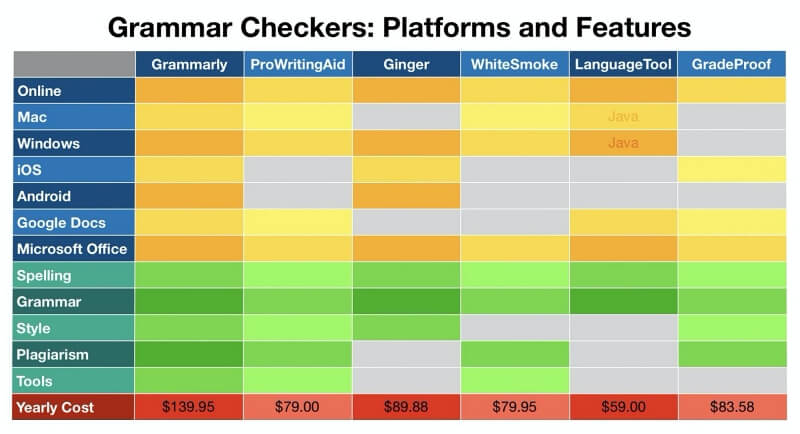
Note that each app provides the basic functionality of checking your spelling and grammar. If you need additional functionality, you need to make sure you choose an app that offers it. Grammarly and ProWritingAid are the only programs that do it all.
Test Document
When evaluating each app, it’s important not to simply list the features offered, but also determine how effective each app is at doing its job. I put together a brief test document containing intentional errors and had each app correct it. Here are the errors:
- An actual spelling mistake: “errow.” All apps identified this error and gave the correct suggestion, except WhiteSmoke, which suggested “arrow” instead of “error.”
- UK spelling instead of US: “apologise.” When set to US English, all apps identified the error except WhiteSmoke and LanguageTool.
- Dictionary words that are wrong in context: “some one,” “any one,” “scene.” Each app identified “some one” and “any one,” but Ginger and WhiteSmoke missed “scene.”
- A misspelling of a well-known company: “Gooogle.” Every app except WhiteSmoke identified this error.
- A common miscorrection: “plug in” (used as a verb) is sometimes wrongly corrected to “plug-in” (which is a noun). Only Grammarly and WhiteSmoke incorrectly suggested I should change the correct wording.
- A mismatch between the number of the subject and verb: “Mary and Jane finds…” Only Ginger and LanguageTool missed this error. The Mac and online versions of WhiteSmoke, which will receive updates very soon, missed it as well. This sentence is a little tricky because the word directly before it is singular (“Jane”), so the app has to check back further to determine that the subject of the sentence is plural. When I replace “Mary and Jane” with “People,” every app notices the error.
- An incorrect quantifier: “less” where “fewer” is correct. Only Ginger and WhiteSmoke missed this error.
- A sentence with an extra comma. Most grammar apps miss a lot of punctuation errors. Grammarly is an exception and seems quite opinionated about the subject. It’s the only app to pick up this error.
- A sentence with a missing comma (assuming Oxford usage). Grammarly complains of the missing Oxford comma every time and was the only app to pick up the error.
- A sentence with blatantly wrong punctuation. I thought that a sentence with a lot of blatant punctuation errors would be easier to correct. I was wrong. Some of the apps flagged double commas or double periods, but none corrected every punctuation error.
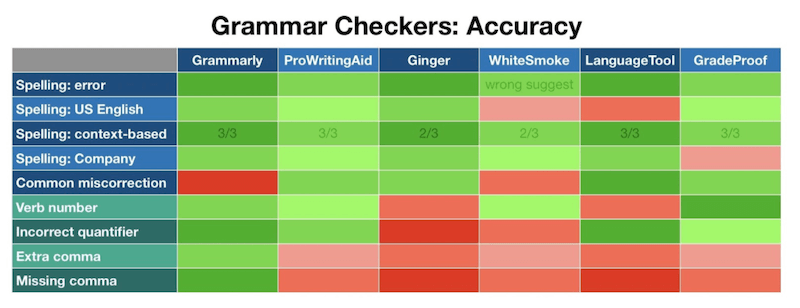
Real Document
I also wanted to get a more subjective sense of how helpful each app is in the real world. I ran one of my draft articles through each app to see which errors were picked up and evaluate whether its style suggestions would make the article clearer, more readable, and more engaging.
Ease of Use
How easy is the app to use? Are the corrections clear and easy to see? Are any explanations helpful and to the point? How easy is it to make the suggested corrections?
How easy is it to move your text into and out of the app? Ideally, it is best if the app is integrated into the word processor or writing program that you use. When pasting or importing documents, you usually lose something—typically styles and images, and sometimes formatting—so using the app that way can require a significant change in workflow, which isn’t always convenient.
At SoftwareHow, we submit our articles for editing via Google Docs, so I would naturally prefer an app that integrates with that environment. Other writers track editing changes in Microsoft Word, so Office integration is also highly valued. Some may prefer to check grammar where they write, so Scrivener fans may find ProWritingAid the best choice.
Price
Free Plans
Many grammar checkers offer free plans. These don’t offer every feature and are designed to let you get a feel for the app without spending money. Grammarly’s free plan is generous and offers full spelling and grammar checking. By contrast, ProWritingAid’s free plan is extremely limited, allowing you to check only 500 words at a time.
- Grammarly: checks for grammar, spelling, and punctuation online, on desktop, and on mobile
- Ginger Grammar Checker: use basic features online with limited checks
- LanguageTool: checks 20,000 characters, no Microsoft Office integration
- GradeProof: checks for words that are not in the English dictionary and grammatically incorrect phrases
- ProWritingAid: limited to 500 words at a time
Premium Plans
Premium plans offer all available features. If you regularly perform plagiarism checks, some apps (ProWritingAid, WhiteSmoke, and GradeProof) may entail additional fees. Here are the currently-advertised subscriptions sorted by price.
- LanguageTool: $59/year
- ProWritingAid: $79.00/year not including plagiarism checks, which cost from $10 extra per year
- WhiteSmoke: $79.95/year ($59.95/year online only), includes a limited number of plagiarism checks
- GradeProof: $83.58/year (or $10/month)
- Ginger Grammar Checker: $89.88/year (or $20.97/month or $159.84 biyearly)
- Grammarly: $139.95/year (or $20/month)
Only ProWritingAid offers a free (two-week) trial period for their Premium plan. Their free plan is quite limited, though. They are also the only company with a lifetime plan, which costs $299 and includes all upgrades. The app is also included in Setapp, a Mac-based subscription service offering almost 200 quality apps for $10/month.
WhiteSmoke offers neither a free plan nor a free trial. To try their software, you need to pay for a full year in advance but can request a full refund within seven days if it doesn’t suit you.
Discounts
The quoted prices aren’t the end of the story. Some companies offer significant discounts after the trial period or regularly, and you can save a lot of money by renewing your subscription at the opportune time.
- Ginger’s current prices are listed as 30% off. I’m not sure if that’s a limited offer, so I didn’t adjust the prices above.
- WhiteSmoke’s current prices are listed as 50% off. I’m not sure if that’s a limited offer either, so I didn’t adjust the prices above.
- GradeProof currently offers a promo code for 30% off.
- WhiteSmoke sent me an email offering 75% off (limited to the first 100 customers).
- ProWritingAid offered me 20% off just as my free trial was finishing.
- I receive emails from Grammarly offering typically 40 or 45% off every month. From time to time, it’s as high as 50 or 55% off.
That means if the current prices for Ginger and WhiteSmoke are limited-time offers, their prices may go up to $128.40 and $159.50, respectively. That would make WhiteSmoke the most expensive app included in our roundup. On the other hand, if you take advantage of Grammarly’s discounts, it will cost $75/year (or if you’re lucky, as little as $63). After signing up for a free account, I received discount offers every month.
